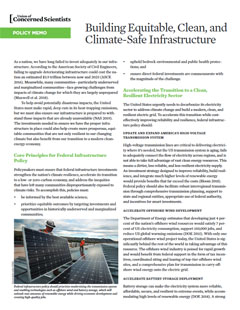The United States has long failed to invest adequately in infrastructure. According to the American Society of Civil Engineers, failing to upgrade deteriorating infrastructure could cost an estimated $3.9 trillion between now and 2025. Meanwhile, many communities—particularly underserved and marginalized communities—face growing challenges from climate change impacts for which they are largely unprepared.
To help avoid potentially disastrous impacts, the United States must make rapid, deep cuts in its heat-trapping emissions. It also needs to invest in infrastructure to better withstand those impacts that are already unavoidable. Done properly, infrastructure investments will help create more prosperous, equitable, and resilient communities that also benefit from our transition to a modern clean energy economy.
Core principles for federal infrastructure policy
Policymakers must ensure that federal infrastructure investments strengthen the nation’s climate resilience, accelerate its transition to a low- or zero-carbon economy, and address the inequities that have left many communities disproportionately exposed to climate risks. To accomplish this, policies must:
- be informed by the best available science;
- prioritize equitable outcomes by targeting investments and opportunities in historically underserved and marginalized communities;
- uphold bedrock environmental and public health protections; and
- ensure direct federal investments are commensurate with the magnitude of the challenge.
To learn more about climate-smart infrastructure listen to our recent interview with Susi Moser on the Got Science? podcast.
Downloads
Citation
Gomberg, Sam, Shana Udvardy. 2019. Building Equitable, Clean, and Climate-Safe Infrastructure. Cambridge, MA: Union of Concerned Scientists. https://www.ucsusa.org/resources/building-equitable-clean-and-climate-safe-infrastructure




